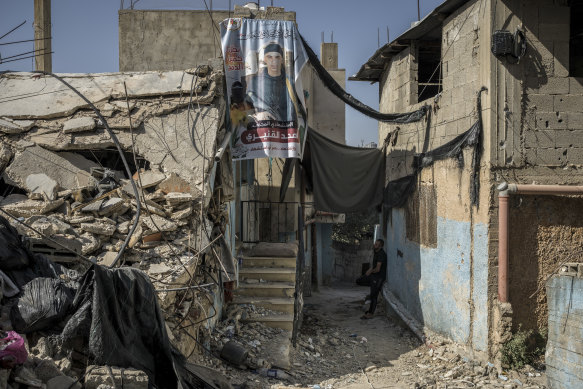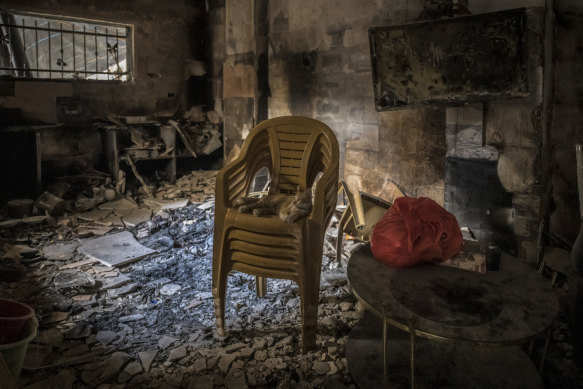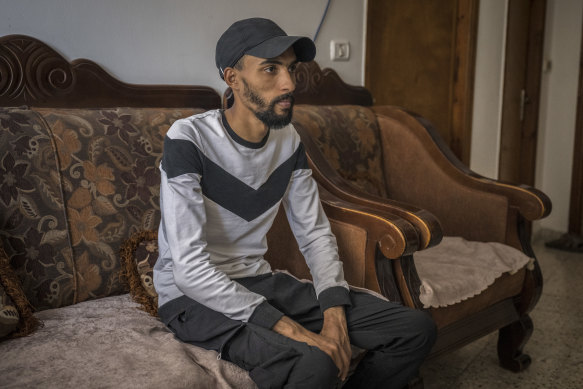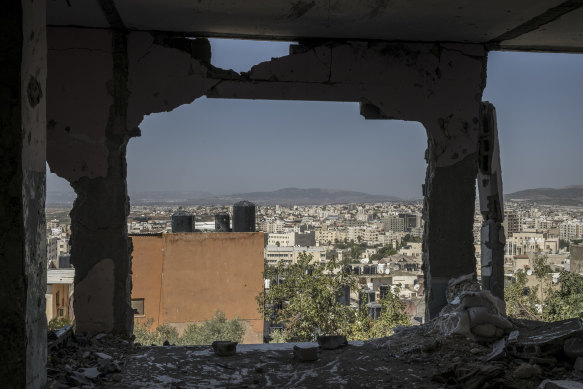
Before Hamas attacked Israel on October 7, 2023, Israeli airstrikes on the West Bank were relatively rare, experts said, with only a few confirmed cases.
But during the raids in Jenin and other Palestinian areas beginning in August, the Israeli military reported carrying out about 50 airstrikes on the West Bank.
More than 180 people have been killed in airstrikes on the territory in the past year, including dozens of children, according to the United Nations and the Palestinian human rights group Al Haq. The Israeli military declined to provide a death toll, but contended that “98 per cent” of the people killed in airstrikes were “involved in terrorist activities”.

A banner featuring a fighter in Jenin, West Bank.Credit: Sergey Ponomarev/The New York Times
The strikes have caused extensive damage to roads, electricity networks and water and sewage lines. Local, international and UN humanitarian workers say Israel has disrupted their relief efforts, while videos verified by The New York Times appear to show Israeli bulldozers blocking emergency vehicles from passing. (The Israeli military said it operated in accordance with international law.)
Instead of calling them raids, residents, aid workers and some experts have likened what is happening in the West Bank to a war.
“We call Jenin a small Gaza,” said Saleem al-Sade, a member of a neighbourhood council.

The burned interior of a house hit by an Israeli strike in the Nur Shams refugee camp, Tulkarm, West Bank.Credit: Sergey Ponomarev/The New York Times
As he walked through a neighbourhood known as Jenin camp, which started as a refugee camp for Palestinians displaced from their homes in what is now Israel, he pointed out the constant sound overhead of Israeli drones that carry out surveillance and airstrikes.
“It’s a Gaza-fication of the northern part of the West Bank,” said Nadav Weiman, director of Breaking the Silence, an advocacy group made up of former Israeli soldiers who say they are collecting testimonies from soldiers who took part in the raids in Jenin and another city, Tulkarem.
Raids into Palestinian areas of the West Bank have become common since the October 7 attacks last year. Beyond the armed drones, bulldozers have ripped up roads, which the Israeli military says is to unearth explosives buried beneath the pavement.
But the strikes in the past few months were some of the most extensive and deadly in the West Bank in two decades.

Palestinian children play under tarpaulins hung up to block the view of Israeli drones in the Nur Shams refugee camp, Tulkarm, West Bank.Credit: Sergey Ponomarev/The New York Times
The Israeli military described the raids as a “counter-terrorism operation” to crack down on Palestinian armed groups and to combat rising attacks against Israelis, including shootings and attempts to set off car bombs. The violence has accompanied a surge in attacks against Palestinians in the West Bank by Israeli settlers who often operate with impunity.
In its operations in the West Bank, the Israeli military said it had killed or detained dozens of fighters, confiscated explosives and destroyed command and control centres. It added that it carried out airstrikes “in situations where arrests cannot be made due to real risk to the forces.”
The military’s actions in the West Bank were long shrouded in secrecy, but experts said Israel had largely refrained from conducting airstrikes on the territory since the end of the second intifada, nearly 20 years ago. At times, Israel used attack helicopters in select operations, but experts said that happened in only a few cases that they knew of over the two decades.
The Israeli military’s deployment of armed drones appeared to have been exceedingly rare. Palestinian reports of it emerged in 2022, but only a few cases were confirmed before October 7, 2023.

Nasir Damaj at his house in Jenin. He says he was used as a human shield by Israeli soldiers.Credit: Sergey Ponomarev/The New York Times
Since then, Israeli forces have carried out dozens of strikes in northern areas of the West Bank, largely concentrated in the cities and towns of Jenin, Tulkarem, Nablus and Tubas.
In visits to Jenin, Tubas and Tulkarem, the Times encountered multiple accounts of Palestinians being forced to perform potentially dangerous missions for Israeli soldiers. The destruction from blasts was widespread, leaving families grappling with the losses of their loved ones in rapid succession.
Israeli forces conducted an airstrike on August 26 in the Nur Shams refugee camp in Tulkarem on what it described as an “operations room”, killing five people, including a 15-year-old, Adnan Jaber, whom Israel accused of manufacturing explosives.
“Immediately, the Israeli news announced they had killed a terrorist,” said Aysar Jaber, Adnan’s father. “But he was a young kid, not a terrorist.”
His son had been taking classes to become a barber, Jaber said. “He had about two weeks left, and he was killed.”

A view of Jenin in the West Bank from a mosque destroyed by an Israeli airstrike.Credit: Sergey Ponomarev/The New York Times
On August 28, an Israeli aircraft struck what the military said were militants in an alleyway in the Faraa refugee camp. Residents recounted how a home was hit, as well, killing two brothers, Muhammad Masoud Muhammad Naja, 17, and Murad Masoud Muhammad Naja, 13, and critically injuring a third brother and the boys’ father.
In September, the Israeli military said its aircraft had struck “terrorists who hurled explosives and shot at the security forces” and had “eliminated” a person “armed with an explosive device”.
Loading
Residents said Israeli soldiers had shot Majed Fida Abu Zeina, 17, and had fired upon ambulances that tried to rescue him, ultimately using a bulldozer to dump his body outside the camp.
“The soldiers are doing whatever they want,” said his mother, Amal Abu Zeina.
The raids in Jenin and other cities over 10 days killed 51 people, according to the Palestinian Health Ministry, which does not distinguish between combatants and civilians. Seven children were among those killed, according to the United Nations.
On the morning of August 28, when Israeli forces launched their raids into Jenin, Tulkarem and Tubas, Israel’s foreign minister at the time, Israel Katz, posted on social media, “we must deal with the threat just as we deal with the terrorist infrastructure in Gaza”.
Human rights groups and aid workers are warning about what they call the dangerous parallels.
“We all have this sense that the pattern of Gaza, the modus operandi, is being applied in the West Bank, and it’s very worrisome,” said Allegra Pacheco, who leads a consortium of Western-backed aid groups in the West Bank.
“The current Israeli government’s objectives in the West Bank aim to force Palestinians out of targeted areas using the same Gaza type of massive force, weaponry and destruction,” she added.
United Nations officials, warning of “lethal warlike tactics” in the West Bank, tried to get into Jenin to carry out an assessment but were denied access by Israeli authorities, UN spokesperson Stephane Dujarric said in September.
During the raids, Damaj’s mother, Amal Damaj, 48, said, “I was so afraid”.
“These are the most intense raids I’ve ever seen, I’ve ever experienced.”
Once in the cave, Damaj recounted how the only light came from the drone in his hands.
From above, the commander watched the live feed on an iPad and yelled out instructions on where to go and what to approach, Damaj said.
Seemingly satisfied that it was safe, the three soldiers and the commander joined Damaj in the cave and interrogated him, demanding to know the location of members of armed Palestinian groups.
“I don’t know – I don’t get involved,” Damaj said he told them.
“‘You’re a liar – you’re living in the neighborhood of the terrorists,’” he said the commander yelled at him. “‘Speak the truth or I’m going to shoot you in the legs.’”
After more than two hours, he said, they let him go. The next day, the Israeli military returned and blew up the cave.
Loading
In response to questions about two cases involving the use of human shields in Jenin, including Damaj, the Israeli military said, “The incidents mentioned in the inquiry appear to contradict IDF orders,” using the initials for Israel Defence Forces. It added that it did not have enough information to confirm or deny whether the episodes took place.
It did confirm an action involving the cave, however, saying “an underground combat facility located beneath a mosque was destroyed”.
In 2005, Israel’s Supreme Court ruled that the military’s use of civilians as human shields violated international law and banned the practice.
“You cannot exploit the civilian population for the army’s military needs, and you cannot force them to collaborate with the army,” Ahron Barak, then chief justice, wrote in the ruling.
Palestinians in the West Bank say the practice never stopped.
Ahmed Bilalo said Israeli forces had given him a lighter and ordered him to torch the strings holding up the curtained tarps above the narrow alleyways of Jenin camp, which fighters often use to obscure themselves from view.
“If I said ‘no’, I knew they would beat me up,” he said.
Weiman, who leads Breaking the Silence, the advocacy group of former Israeli soldiers, said the overall military approach being used in the West Bank was known as the “Dahiya doctrine,” a reference to Israel’s flattening of the Dahiya, the collection of neighborhoods in southern Beirut that is a Hezbollah stronghold, during its 34-day war in Lebanon in 2006.
The tactic creates disproportionate damage to civilian infrastructure and is aimed at trying to cause so much damage and destruction that civilians turn against armed groups in their areas, he said.
“That kind of pressure wasn’t imposed on villages and towns in the West Bank until very recently,” he said.
The Israeli military rejected his assessment, saying, “The claim that the IDF deliberately causes harm to civilian infrastructure is false.” Instead, it has long accused Hamas and other armed Palestinian groups of embedding themselves in civilian areas.
The day after the Israeli military forced Damaj into the cave, it returned and ordered Khalid Salih, 59, a school attendant, and his wife to leave their home before it was blown up, the couple said.
When they returned after the explosion, Salih said, the shock at seeing their home destroyed felt as if someone had punched him in the head. The house is uninhabitable.
The mosque above the cave had been destroyed by an airstrike, killing four people, according to residents. Israel’s military said at the time that it was targeting an underground “terror compound” being used by Hamas and Islamic Jihad to organise an imminent attack.
Aseel Mustafa Salih, who is married to Salih’s nephew and lived in an adjacent apartment, was asleep at home with her husband and two young children when the mosque was struck.
Loading
“I woke up and thought our house was the one that was struck,” she said, adding that the airstrike broke some of their windows.
Downstairs, Salih and his wife were thrown from their beds and across the room from the blast, he said.
Half an hour after the October 22 strike, Salih said, she received a text message from the Israeli military instructing her to leave the area: “You are in a place that is not safe.”
This article originally appeared in The New York Times.



























